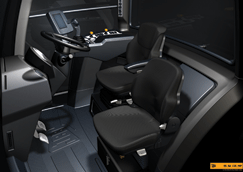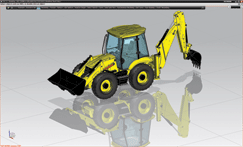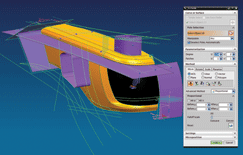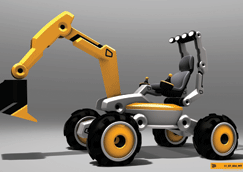Earlier this year JCB celebrated the production of its one millionth machine. If laid end to end that’s enough diggers to stretch from the UK all the way to Australia.
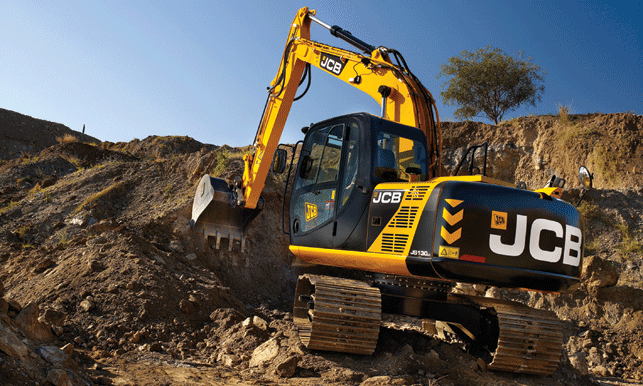
The 13 tonne JCB JS130 tracked excavator
The millionth machine, a 22 tonne JS220 tracked excavator, now takes pride of place in JCB’s Rocester HQ reception area, polished to within an inch of its life.
Not bad for a company that started out 67 years ago from the garage of Joseph Cyril Bamford.
Today its headquarters remain in North Staffordshire, not far from that garage in Uttoxeter, with Bamford’s eldest son, Sir Anthony Bamford, at the helm.
Originally supplying agricultural equipment, the company has diversified over the years and today manufactures over 300 products from excavators and backhoes to skid steer loaders, forklifts and even military vehicles.
These products, 75 per cent of which are exported to 150 countries across the world, are produced in 22 manufacturing plants – 11 in the UK and 11 overseas.
Following the establishment of its first overseas operation in India in 1979, still one of its biggest markets, the company has subsequently moved into Brazil, USA, China and Germany.
Sir Anthony Bamford claims that the reason JCB’s machines are so popular in a competitive global marketplace is due to continued innovation.
This innovation is the responsibility of the design team whose facilities and technologies rivals that of McLaren and Aston Martin.
Although we have to take their word for it because the brand new Rocester design studio is like Fort Knox with no press allowed access. Considering the substantial number of innovative new machines currently in development, this is understandable really.
Localised products
Being a global manufacturer means understanding the different markets the products are designed for and often tailoring them for specific localised users.
For instance, the Indian backhoe is localised with features that address its particular culture.
Due to this localisation, JCB has a number of regional design centres. In India there is a large one in Pune and a smaller design team located at its manufacturing plant in Delhi, which builds 100 backhoes a day – just for the Indian market.
There is also a design team in the US who work on the skid steer machines as well as the military backhoes, which makes sense as these products are predominantly used in that market. Then both Shanghai and Germany have small design teams too.
Tools for the job
Although the industrial designers use Alias all the engineering and CAD is carried out in Siemens PLM Software NX and Teamcenter.
There are 600 users of NX across the group with just two staff in the Rocester HQ offering all the training and support.
“When we upgraded to NX 7.5 18 months ago, it was the busiest year of my working life as I flew out to the various locations and trained all the users,” comments JCB’s group CAD specialist.
In fact, he remembers helping to set up the Pune design centre back in 2006. At that time it consisted of just eight people, today there are 200 and in two years he predicts this will expand even further still.
As a result, a great deal of effort goes into training these engineers not least of all because a lot of them carry out the detailing work for the rest of the group.
“The full on engineers concentrate on the CAD work and farm out the drawings to the Pune design centre who do all the detailing and drawing packages for us. They’ll even release it on an engineering release workflow on Teamcenter,” explains JCB’s group CAD specialist.
However, in addition to CAD training, project leaders from the UK will actually go to Pune for anywhere between two weeks to three months to work in teams with the engineers over there.
Additionally, work permits allowing, the Indian engineers are brought over to work alongside the engineers in a particular business unit in the UK (such as JCB LandPower in Cheadle or JCB Heavy Products in Uttoxeter) for a six month period.
This is not only useful to forge relationships with their UK colleagues but to also experience the company culture, which they then take back with them. “It’s a really good way of a company this size when you are split across the globe to have that relationship and knowledge of what we are doing,” says JCB’s group CAD specialist.
Workstation refresh
Just as CAD upgrades affect engineering operations, so does a workstation upgrade.
“From a support point of view it really helps if everybody is using the same kit in the same set up as NX and Teamcenter can behave differently depending on the platform the user’s on,” says JCB’s group CAD specialist.
Just a few months back 250 workstations were refreshed in the UK offices. The outgoing Lenovo ThinkStation S20 was replaced with the newer ThinkStation S30.
The biggest change is that the rotational disc style hard drive (150GB HDD) has now been replaced with an Intel solid state drive (SSD) with 180GB capacity and a Nvidia Quadro K5000 graphics card.
“What we find with Lenovo is that they are so competitive and the quality of the kit is brilliant. It’s very cost competitive in the volume that we buy them – basically we can upspec the equipment for virtually no extra cost,” says JCB’s group CAD specialist.
The new ThinkStations have delivered some big gains on the simulation side where JCB’s Ansys users are finding things to be three times faster. However, the new machines haven’t cut the time taken to load and process CAD models.
To address this, JCB’s group CAD specialist, along with other key CAD users, are currently looking at ways to reduce the size of the CAD models by breaking them down into smaller individual parts.
Through WAVE linking all the parts can be brought together in one single file and WAVE link will unite them together. This will mean that the feature history for the finished component is literally a few linked bodies with 70 to 80 features and not 6,000 as there are in some of the current CAD models.
In relation to this, having been involved in the beta testing for NX 8.5, which they are hoping to implement at the end of 2013/beginning of 2014, he is looking forward to the modular design functionality. The ability for complex designs to be broken into isolated, self-contained functional elements that evolve independently will prove extremely beneficial to them.
Key challenges
Working with NX day in and day out and being the point of reference for 600 users, means that JCB’s group CAD specialist is all too aware of the issues they are fighting on the CAD side.
There are three key challenges.
The first challenge is legacy data. JCB has CAD data dating back to the mid 90s which is still kicking around its system.
Due to its multi-site operation and with re-filing not possible at the moment, there are copies of files on each site with ownership on another site so many legacy models don’t yet have the smart light weight models.
The PLM team is currently working on a project that will mean re-filing will be viable and the subsequent benefits of the new light weight models will be available to all. This will hopefully be achieved soon when the current multi-site setup is switched to a four tier architecture.
The second challenge is the quality of technical drawings, especially when it comes to university graduates who join the company with very little drawing skill.
“You’ve got young guys going into our various divisions where they are detailing complex components etc, and it’s a real struggle, as the skills required to detail a high quality engineering drawing are not taught in depth as part of a modern engineering degree,” explains JCB’s group CAD specialist.
The slick workflows and engineering sign off have been refined within Teamcenter and controls have been put in place to try and ensure that all drawings are to the highest standard, however complacency should be avoided and continued training is the only way to ensure that the quality of work matches JCB’s exacting standards.
Consideration has been made regarding bringing back retired engineers on part time contracts to help train young engineers how to create drawings. Another solution is the establishment of the recent JCB Academy (see box piece below), which is training young engineers in vital engineering skills.
The third challenge is engineering contractors who are brought in to help on a specific project.
Although they claim to be proficient in NX, some quite clearly need bringing up to speed with the latest release. One solution, according to JCB’s group CAD specialist, is to instigate a CAD certification process to ensure that there is no loss of productivity by those who can’t use the tools.
However, despite these challenges JCB is a company that is expanding and thriving. It certainly won’t be another 67 years until its second millionth machine is produced.
jcb.com | plm.automation.siemens.com
Heavy load – How JCB combines physical test and digital simulation
With its products operating in harsh environments and customers requiring robustness and maximum up time, simulation and analysis is core to JCB’s product development process.
There are four cornerstones to JCB’s simulation sign off process; Finite Element Analysis (FEA), hydraulic rig testing, field endurance testing and strain gauge measurement.
Each of these either input real world data or provides output results for correlation to the others. JCB’s principal engineer for dynamic structural analysis explains, “Provided that we pass all four of those tests, we have a product that is more than fit for service.”
In terms of process, he explains, “We’ll pull the CAD model into Ansys, mesh it up, add the boundary conditions that we think fit — either based on previous work or calculations. We’ll run that and get some results out.
They’ll show hot spots and areas of concern. It will either be OK, need adjustment or perhaps we want to do some optimisation and take some cost out of the design.”
Correaltion is key
“We’re largely a fabrications company,” explains the principal engineer. “Ninety-five per cent of our issues aren’t with the plate, but with the weld conditions. So, how we look at those weld conditions is the really important thing.”
In terms of bringing together the digital simulation world with the physical test data, he comments that, “If we haven’t got anything to correlate our first FEA pass we will wait for the strain gauge results. Then we’ll do an iterative loop when they’re ready. That will tell us how far out we are, if at all. We’ll then go back and refresh the FEA and bring it closer to where we need to be. If we’re close enough, FEA can be validated and the design can be signed off based on FEA alone.”
Cost saving
JCB’s principal engineer for dynamic structural analysis also discussed the cost difference between its physical and increasingly more digitally driven process.
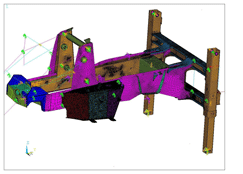
“Before we started using FEA, an exhaust system could cost £5,000 to test and we could have been doing two, three, or sometimes five, tests before we got to a useful point. Now we can usually do it with one iteration and a bit of tweaking – depending on the complexity of the system.”
Geographic variation
The result of having a geographically diverse business has also historically brought challenges for JCB’s simulation team.
Previously, the difference in use case, loading conditions and variations in manufacturing processes meant that separate simulation studies had to be conducted.
Welding by hand in lower cost economies often meant big differences compared to western robotic welding.
As Eastern manufacturing has been modernised, some countries are still considered to be the heaviest users, but the improvement in local manufacturing means this is much less of an issue and often the same product can be specified globally, as long as meets those localised demands.
The JCB Academy
The JCB Academy, based near the company headquarters in Rocester UK, is the first University Technical College in the UK to deliver high-quality engineering and business education to students from the age of 14.
The inspiration for the Academy came from JCB Chairman Sir Anthony Bamford in 2006 and the school opened its doors to its first pupils in September 2010.
In fact, JCB has just had its second intake of apprentices from the JCB Academy, who have come into the business having worked on real-life engineering projects.
“The JCB Academy was established to develop employability skills amongst young people and to enable them to achieve great academic and technical qualifications,” says JCB Academy Principal Jim Wade.
“We are really pleased that many of our young people are moving on to apprenticeships with many of the key employers across the region.
These young people are leaving The Academy with the core skills they need to have successful and fulfilling careers within the engineering industry.”
jcbacademy.com
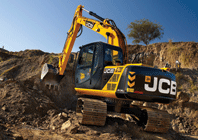
Siemens PLM software and Lenovo hardware drive JCB’s global success
Default


